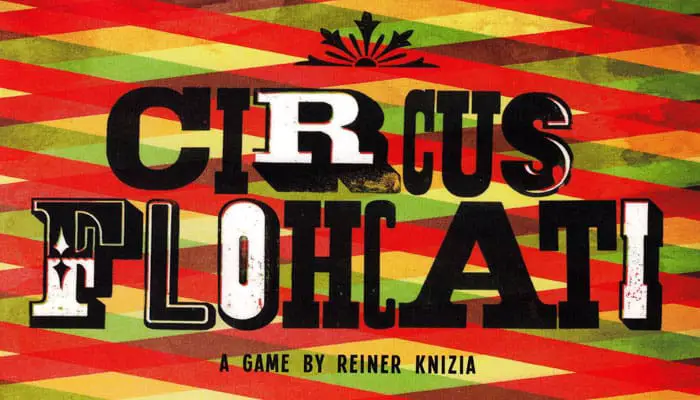
The circus is in town, but not the one with lions and tigers and bears, oh no! This is the smallest circus known to man: the flea circus.

Components
- 80 circus cards - 8 each in 10 kinds of fleas
- 9 action cards
- rule booklet
Setup
Shuffle the circus cards and the actions cards together. Place them face down in the middle of the table as a draw stack.
The players choose a starting player and he begins the game. Thereafter, players take turns in clockwise order.

Game Play
On a player's turn, he first may turn over cards from the draw stack, one at a time, placing them next to the draw stack side-by-side:

The player may turn over as many cards as he wishes, but need not turn over any cards. He may stop turning cards whenever he chooses, but must stop when he turns a card that matches a the color (flea) of a card already in the side-by-side cards.
If he is forced to stop by turning a matching card, he discards the card just turned and ends his turn!

If a player stops turning cards before he turns a matching card or chooses not to turn cards, he may take any one of the face-up side-by-side cards, adding it to his hand.
If, after taking a card, a player has a set of three cards of the same value, he may place them face up in his play area. Each such set will be worth 10 points at the end of the game. Once placed, however, they may not be picked up!

Action Cards
There are 9 action cards in the deck, 3 each of 3 kinds. When a player turns such a card, he must take the action indicated by the card:
New Attraction

When a player turns this action card, he discards it face up on the discard stack and may continue turning cards until he turns a card that matches the color of a card already in the side-by-side cards.
In this case, he may take one of the face up side-by-side cards, adding it to his hand. If he does not take the last-turned card, he then discards it. As always, he may stop turning cards at any time.
If a player turns other action cards while turning cards after he has turned a new attraction card, he discards them face up on the discard stack, without taking the actions indicated on the cards.
Take Attraction

When a player turns this action card, he discards it face up on the discard stack and chooses and opponent to take a card from.
The opponent fans his hand cards, back sides toward the taker, and the taking player takes one card from the player's hand, adding it to his hand and ends his turn!
Request Attraction

When a player turns this action card, he discards it face up on the discard stack and requests a specific color (flea) card from his opponents. He names the color (flea) and a direction: clockwise or counter-clockwise.
Then starting with his left neighbor (clockwise) or his right neighbor (counter- clockwise), each player, in turn, must give the player one card matching that color from his hand or pass, indicating that he does not have a card of that color in his hand.
A player may not pass if he has a card of the color requested. Once a player has given the requestor a card, the action ends. The other players do not give up cards. If no player has a card of the requested color, the requestor gets nothing and ends his turn!
End of the Game
The game can end in either of two ways:
-
When the last card is drawn from the draw sack, the player drawing the card ends his turn and the game ends immediately.
-
When a player has at least one card of each of the 10 colors (fleas) in his hand, he may choose, at the end of his turn, to end the game immediately.
He tells the other players the game is over and places his hand cards face up on the table, so all players can see that he has all 10 colors. If the player does not have all 10 colors, he takes his cards back into his hand and the game continues.
At the end of the game, the players score their hands and the card sets they have placed in their play areas:
A player scores 10 points for each card set (3 cards of the same value) in his play area.
A player scores the value of one card of each color in his hand (the highest valued card). Additional cards of a color in a player's hand do not score.
The player with the most points is the winner.
If two players tie with the highest score, they rejoice in their shared victory!
Example:
A player has the folowing cards in his play area:
and the folowing cards in his hand:
The player scores 20 points for the two sets (10 each) and 27 points for the cards (marked with ) in his hand (6+4+0+7+5+5). The 3 cards that duplicate colors (marked with ) do not score.
Continue Reading


